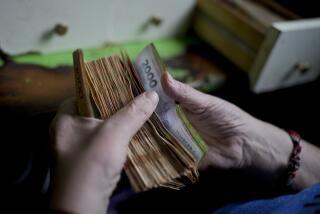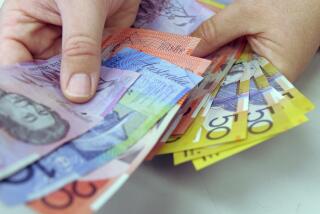Few Cheers for Australiaâs Plastic $5 Bill
SYDNEY, Australia â The government sees the future in its new plastic folding money, but many Australians are put off by the slippery feel. They donât like the idea of taking copper coins out of circulation, either.
Withdrawing the 1- and 2-cent coins and rounding out prices to the nearest 5 cents is creating an entire generation of entrepreneurs. Clever children go into candy stores, pick out something for 2 cents and ask that the bill be rounded out to nothing.
The new $5 note, the first of several plastic bills due in the next few years, is criticized not only for its slick feeling, but because it is smaller and replaces the likeness of Caroline Chisolm, a 19th-Century philanthropist, with that of Queen Elizabeth II.
âWhen they first came out, some customers refused to have them,â said Judith Jones, head teller at a branch of the Westpac Bank. âTheyâre very hard to separate, very slippery, very hard to count, and theyâre tiny, which makes them hard to use with the other denominations.â
The Royal Australian Mint, responsible for collecting the coins for sale to smelters, has retrieved only about 3,000 of the 20,000 tons that were put into circulation
âWeâre not too sure whatâs happened to them,â said Susan Whitbread, a spokeswoman for the mint.
âNew Zealand went through this a couple of years ago and they only got about 25% back. Some people apparently feel itâs almost not worth the trouble to bring them in.â
Australia decided on plastic notes, which last longer and stay cleaner than paper, after a commemorative $10 plastic bill was issued for the countryâs bicentennial in 1988. Studies indicated that most people liked it, despite some reservations.
Federal Reserve Bank officials have been somewhat surprised by the depth of feeling about the $5 note, but hope that people will adapt as in the mid-1960s, when Australia switched from the British pound system to decimal currency.
The timing of the new issue could have been better. When it was issued early in July, anti-royal sentiment was at a peak. Prime Minister Paul Keating was leading a move to have Australia declared a republic and end the queenâs status as head of state.
Although the queenâs likeness has traditionally appeared on Australiaâs smallest-denomination note, it has been on coins only since the $1 note was replaced by a coin in 1984. A coin replaced the $2 note in 1988.
Bartenders say defacing the queenâs portrait on the new note has become popular, despite possible penalties of two years in jail and a fine of $5,000, equal to about 3,600 American dollars.
âWe get them with horns on her, beards or glasses,â said Eddie Hayes, proprietor of Molly Blooms, an Irish pub in Port Melbourne. âThey know they can get a terrible fine for doing it, but they donât seem to care.â
The central bank admits to withdrawing some notes because of vandalism, but will not reveal how many.
Some Australians say the new bills look and feel like play money.
Roger Simpson, a television news anchor, went so far as to speculate that the new fiver deepens the helplessness many feel in the midst of a recession.
âIt appears the country has nothing of value when its notes look so cheap,â he said. âI really prefer the look of Monopoly money.â
The old $5 notes were a distinctive red. The new ones are a pastel lavender and orange-pink.
Central bank officials cited technological advances in color copiers as a prime reason for the change. The new bills have several anti-counterfeiting features, including a see-through area with a hologram-like sketch of a eucalyptus leaf.
Not everyone is upset by the changes. George Negus, a journalist, said he finds the new $5 notes âquite aesthetically pleasing,â as long as people keep handing him more of them.
More to Read
Sign up for Essential California
The most important California stories and recommendations in your inbox every morning.
You may occasionally receive promotional content from the Los Angeles Times.









